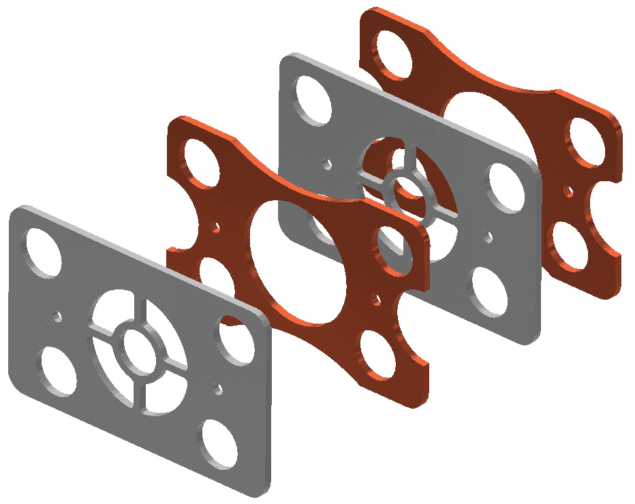Metamaterial boosts performance of wakefield accelerator
18 Jan 2019
A simple metamaterial made from alternating steel and copper plates has been used to improve the tunability and beam quality of wakefield particle accelerators. The work was done in the US by physicists led by Richard Temkin at the Massachusetts Institute of Technology and could lead to a new generation of highly-compact particle accelerators that produce high-quality beams.
Wakefield accelerators operate by firing intense pulses of charged particles into a plasma or dielectric material. The pulses separate positive and negative charges in the target creating a short, intense pulse of microwaves. The electric field associated with the microwave pulse accelerates charged particles that trail in its wake. Since plasmas and dielectrics can sustain far stronger microwave electric fields than the periodic metallic structures comprising the walls of conventional accelerators, wakefield accelerators can boost particle kinetic energies to gigaelectronvolt levels over distances of just metres. In comparison, conventional accelerators can achieve around 100 MeV/m.
However, when it comes to beam quality and tuneability, wakefield accelerators lag far behind conventional accelerators.
Best of both worlds
In their study, Temkin’s team aimed to construct a “best of both worlds” device that achieves the strong acceleration gradients characteristic of wakefield acceleration, while improving the quality and tunability of the beams they produce. This involved constructing a simple, periodic metallic metamaterial that replaces the plasma or dielectric material. Their 8 cm-long structure comprises a stack of 2 mm-thick wagon wheel-shaped plates; alternating between steel and copper.
Since the separation between plates of the same material is far smaller than the wavelengths of the microwaves produced by driving electrons, the waves were not affected by the presence of individual plates. Rather, the metamaterial behaves as a single composite medium with its own unique properties.
By adjusting their metamaterial’s geometry, the team could tune its properties to allow for shorter, more intense microwave pulses. This minimizes both the risk of electric breakdown, and the electric field escaping from the structure’s walls.
Reverse velocity
The physicists carried out preliminary testing of their metamaterial’s performance at the Argonne Wakefield Accelerator Facility in Chicago, allowing them to measure an acceleration gradient of 75 MeV/m for one driving electron pulse. Through adjusting the metamaterial, they also caused the group velocity of the microwaves to point backwards relative to the driving electrons. This allowed allow more energy to be extracted from the electrons.
From these tests, the physicists estimated that with shorter, more energetic driving electron pulses, they could achieve acceleration gradients as high as 300 MeV/m, with high beam qualities compared with previous wakefield accelerators. This could be feasible with the upcoming FACET-II facility at the Stanford Linear Accelerator Center, which will begin operation later in 2019.
The team believes their work will lead to progress towards a new generation of accelerators that are compact and reliable enough for everyday use in hospitals and university labs, while also allowing for new advances in fields ranging from particle physics to medical research.
The accelerator is described in Physical Review Letters.
Sam Jarman is a science writer based in the UK
25/1/2019 from physicsworld.com

Δεν υπάρχουν σχόλια:
Δημοσίευση σχολίου